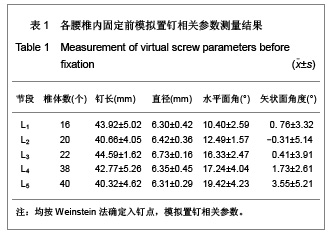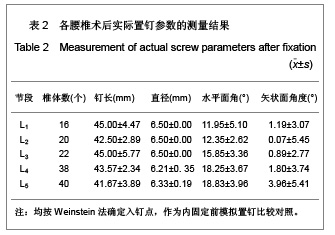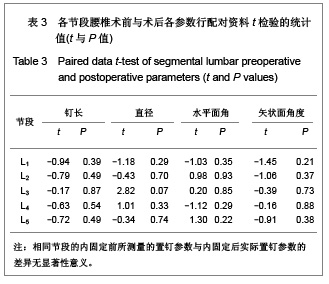| [1] Youkilis AS,Quint DJ,McGillicuddy JE,et al.Stereotactic navigation for placement of pedicle screws in the thoracic spine. Neurosurgery. 2001; 48(4): 771-779.[2] Foley KT,Simon DA,Rampersaud YR.Virtual fluoroscopy: computer-assisted fluoroscopic navigation. Spine.2001;26(4): 347-351.[3] weinstein JN, Rydevik BL, Rauschning W. Anatomic and technical consideration of pedicle screw fixation. Clin Orthop Relat Res.1992;(284): 34-46.[4] West JL, Ogilvie JW, Bradford DS. Complications of the variable screw plate pedicle screw fixation. Spine.1991;16(5): 576-579.[5] Wegener B, Birkenmaier C, Fottner A, et al. Delayed perforation of the aorta by a thoracic pedicle screw. Eur Spine J. 2008;17(suppl 2): S351-354.[6] Hicks JM, Singla A, Shen FH, et al. Complications of pedicle screw fixation in scoliosis surgery: a systematic review. Spine. 2010;35(11): E465-470.[7] Roy-Camille R, Saillant G, Mazel C. Internal fixation of the lumbar spine with pedicle screw plating. Clin Orthop Relat Res.1986;(203): 7-17.[8] Magerl FP. Stabilization of the lower thoracic and lumbar spine with external skeletal fixation. Clin Orthop Relat Res. 1984;(189): 125-141.[9] Krag MH, Van Hal ME, Beynnon BD. Placement of transpedicular vertebral screws close to anterior vertebral cortex: Description of methods. Spine.1989;14(8): 879-883.[10] Tian NF, Huang QS, Zhou P, et al. Pedicle screw insertion accuracy with different assisted methods: a systematic review and meta-analysis of comparative studies. Eur Spine J.2011; 20(6): 846-859.[11] Zausinger S, Scheder B, Uhl E, et al. Intraoperative computed tomography with integrated navigation system in spinal stabilizations. Spine(Phila pa 1976).2009;34(26): 2919-2926.[12] Verma R,Krishan S,Haendlmayer K,et al. Functional outcome of computer-assisted spinal pedicle screw placement: a systematic review and meta-analysis of 23 studies including 5,992 pedicle screws. Eur Spine J.2010;19(3): 370-375.[13] Xiong CZ, Hao JM, Tang TS. Zhonghua Guke Zazhi. 2002; 22(1):31-35. 熊传芝,郝敬明,唐天驷.椎弓根钉道参数的变异性及其相关因素的研究[J].中华骨科杂志,2002,22(1):31-35.[14] Mao XF,Yang B,Li SM.Yingxiang Zhenduan Yu Jieru Fangshexue. 2007;16(4):187-189. 毛晓芬,杨波,李斯明.极外侧型腰椎间盘突出症的CT、MRI表现[J].影像诊断与介入放射学,2007,16(4):187-189.[15] Ke YH,Yin D,Chang YB,et al.Zhongguo Linchuang Jiepoxue Zazhi. 2012,30(1):52-55. 柯雨洪,尹东,昌耘冰,等.CT三维重建在脊柱半椎体畸形矫正手术中的价值[J].中国临床解剖学杂志,2012,30(1):52-55.[16] Forsythe B, Kopf S, Wong AK, et al. The location of femoral and tibial tunnels in anatomic double-bundle anterior cruciate ligament reconstruction analyzed by three-dimensional computed tomography models. J Bone Joint Surg Am.2010; 92(6): 1418-1426.[17] Galibarov PE,Prendergast PJ,Lennon AB.A method to reconstruct patient-specific proximal femur surface models from planar pre-operative radiographs. Med Eng Phys.2010; 32(10): 1180-1188.[18] Müller MC, Belei P, de la Fuente M, et al. Evaluation of a new computer-assisted surgical planning and navigation system based on two-dimensional fluoroscopy for insertion of a proximal femoral nail: an experimental study. Proc Inst Mech Eng H.2011;225(5): 477-486.[19] Song L,Zhong SZ,Li YB,et al.Zhongguo Jiaoxing Waike Zazhi. 2007,15(10):765-767. 宋磊,钟世镇,李严兵,等.经皮手术治疗骶髂关节损伤的临床解剖学数字化研究[J].中国矫形外科杂志,2007,15(10):765-767.[20] Du CL,Ma XL,Zhang T,et al.Shengwu Yixue Gongcheng Yu Linchuang. 2012,16(3):223-227. 杜长岭,马信龙,张弢,等.双侧股骨近端对称性及解剖形态的三维重建研究[J].生物医学工程与临床,2012,16(3):223-227.[21] Yu HL,Xiang LB,Liu J, et al. Zhongguo Jiaoxing Waike Zazhi. 2010,18(2):157-159. 于海龙,项良碧,刘军,等.CT三维重建技术在手术治疗胸腰段椎体骨折中应用[J].中国矫形外科杂志,2010,18(2):157-159. |



.jpg)
.jpg)
.jpg)
.jpg)
.jpg)